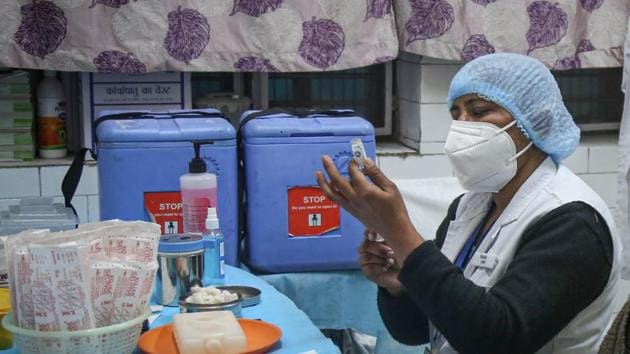No room for complacency in Covid-19 battle
The vaccine is here but its success depends on a robust primary health system
The success of the Covid-19 vaccination programme, now green flagged in India, depends on strong primary health care. Even when the programme gets underway, there can be no let up in ensuring that the health infrastructure is improved steadily.

Covid-19 announced itself to the world as 2020 dawned. The virus blitzed across the world rattling health systems and tripping economies. The year ended with vaccines emerging as defenders against disease, though not of infection per se. Just as humanity was sighting success in its pursuit of this agile adversary, the tricky microbe picked up speed with mutations, conferring increased infectivity. India has now to keep up the public health vigilance against viral transmission, while using the vaccines well to protect the vulnerable and prevent interruption of essential services.
The advent of the vaccines, while very welcome, should not slacken the resolve to strengthen the public health system to combat future pandemic threats as well as raise its functioning in the steady state. Global and Indian experience with Covid-19 over the past year will guide us to chart the path ahead.
During the turbulent year, as millions got sick, clinical medicine stepped in, to show the benefits of old drugs like steroids, lying on the belly (“proning”) and oxygen, even as it applied the rigorous test of large randomised trials to reject false claims. We recognised that the virus spreads through droplets and aerosols to infect us through nose, mouth and eyes. It came as a surprise that it can be transmitted even by asymptomatic and pre-symptomatic persons. Poorly-ventilated spaces and tightly-packed groups of people gave rise to the vast majority of the cases, through super-spreader events.
We learnt that this “respiratory virus” also has a propensity to infect and inflame many other organs in the body, cause clots in blood vessels and unleash a fatal cytokine storm. Beyond an acute infection, it revealed long-term effects on many organs, including the heart, lungs, brain, kidney and pancreas. A variety of tests were employed to detect the virus and antibodies against it. High testing rates alone did not hasten the end of the pandemic or reduce deaths in many countries like the United States (US), contrary to what was predicted in the early stages of the pandemic. Besides testing, public health demanded much more to achieve effective control. Tracing of contacts resurfaced as a public health function, aided by apps but still dependant on a skilled health workforce. Public health measures, such as masks and physical distancing, to curb person-to-person transmission became the major defence, through a combination of health communication and regulation.
India was pulled into the pandemic in late January 2020. Though case counts were small till March, the panic that engulfed Europe and the US suggested that a highly infectious and moderately virulent virus could wreak havoc in countries with shaky health systems. Mounting concern led to a nationwide lockdown on March 25, lasting several weeks. It did give time to prepare the health and social systems for meeting the daunting challenge that lay ahead.
As 2020 ended, India had the pandemic under control. Though the total case count passed the 10 million-mark, placing it second only to the US, it ranks well below other million-plus countries when adjusted for the population size (cases per million). While vagaries of testing rates, methods and criteria left the actual case count in doubt, falling daily death counts provided a better tracker of the decline. Deaths per million population are far lower than in Europe, North or South America. The lower age of the population was protective. A high proportion of the population being rural would have helped, as crowd density and co-morbidity levels are lower. Prior non-specific immunity may have contributed but is unproven.
The virus challenge also exposed the weaknesses of our health system. Even as our low-resourced public health and hospital systems gallantly struggled to cope with the challenge of testing, tracing and treating, other essential health services were marginalised. Child immunisation and nutrition, institutional deliveries, treatment of non-communicable diseases and mental health disorders, as well a number of other health needs suffered from depleted services. The pandemic taught us the lesson that a weak health system cannot generate a swift and strong surge response without compromising its other functions.
The need to invest more in health now has strong social consensus. We must focus on augmenting the scale and skills of a multi-layered and multi-skilled health workforce. Comprehensive primary health care must be the foundation of an efficient and equitable health system. Urban primary care, which has been long neglected must be prioritised.
District and medical college hospitals must be strengthened. Universal Health Coverage, with a higher level of public financing, must be led by a strong public sector with the private and voluntary sectors playing a supportive role. Public health competencies must be enhanced in both central and state health services, through creation of public health cadres. Disease and risk factor surveillance systems must be reinforced. “One Health” surveillance must track microbial migration from wildlife to veterinary clusters and human populations.
Though Covid-19 is an unfriendly visitor, it has delivered a message that we must heed. It tells us to position health centrally in the programme of sustainable development. That must be our resolve in 2021.
K. Srinath Reddy, a cardiologist and epidemiologist, is president, Public Health Foundation of India. He is the author of Make Health in India: Reaching a Billion Plus
The views expressed are personal



